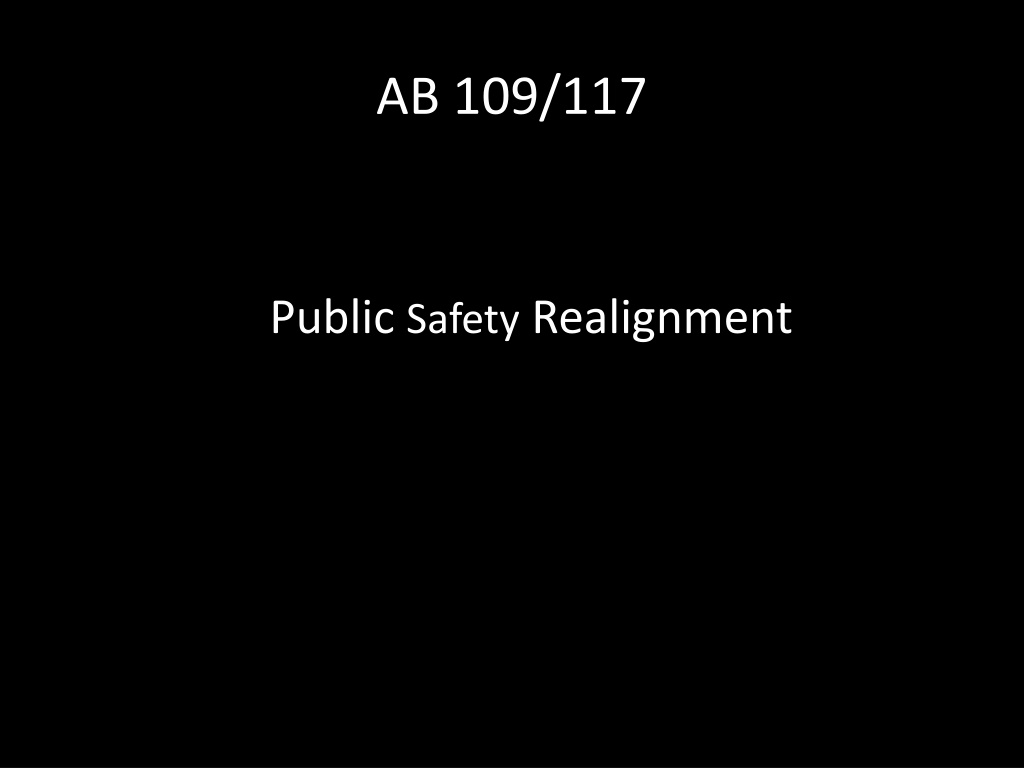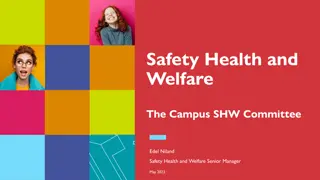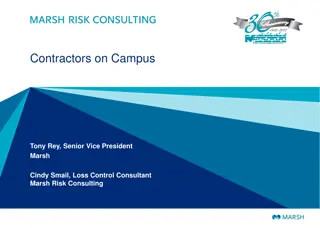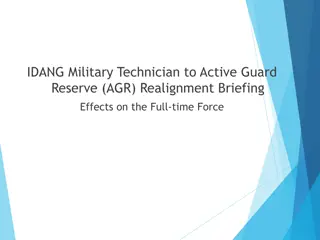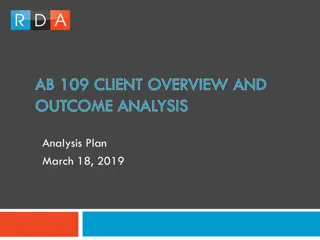Understanding AB 109/117 Public Safety Realignment
AB 109/117 Public Safety Realignment, implemented in California, shifted the responsibility of specific felons to county control, established Post-Release Community Supervision, and introduced new sentencing schemes. It addressed misconceptions about early release and custody transfer from state prison to county jail. The realignment aimed to reduce prison overcrowding, improve public safety, and lower recidivism rates through community-based corrections partnerships.
Uploaded on Sep 10, 2024 | 0 Views
Download Presentation

Please find below an Image/Link to download the presentation.
The content on the website is provided AS IS for your information and personal use only. It may not be sold, licensed, or shared on other websites without obtaining consent from the author. Download presentation by click this link. If you encounter any issues during the download, it is possible that the publisher has removed the file from their server.
E N D
Presentation Transcript
AB 109/117 Public Safety Realignment
AB 109 January, 2011 -Proposed in Governor s budget April -Passed by legislature, signed by Governor June -Funding and clarifying legislation in AB 117, AB 118 with passage of State Budget October 1 - -Public safety Realignment became operative November 1 -Board approved Sonoma County Interim Realignment Plan July, 2012 -Board approved Sonoma County Year 2 Realignment Plan
Why Realignment Coleman/Plata prison overcrowding lawsuit State budget Recidivism rate from CDCR Research
Misconceptions Realignment does not result in early release of any currently sentenced felons. Realignment does not transfer custody of any prisoner from State Prison directly to County Jail. Rather, it changes jurisdiction of specified populations from state to local control, by changing sentencing and supervision requirements
AB 109 Overview Shifted responsibility of specific felons to county control Established Post Release Community Supervision (PRCS) Established new sentencing scheme Tasked Community Corrections Partnerships (CCPs) with planning for, and implementation of local plans
Non-non-non Offenders These offenders are serving their sentences locally, sentenced under PC 1170(h). Typically, sentence structured as some combination of local jail time, with period under Mandatory Supervision by Probation. Current or prior offense must be: Non-violent Non-serious Non-sex Unless excluded by one of 70+ specified crimes
Post Release Community Supervision (PRCS) Probation supervises these offenders upon release from prison: Current Non-violent offenders Current Non-serious offenders Some Sex offenders Does include offenders with a serious/violent offense in criminal history (as long as it s not current offense). Does not include 3rdstrikers
Local Impacts CDCR estimates of ADP for Sonoma County, at full implementation: - PRCS - 164 supervised by Probation - PRCS - 21 in County Jail on violation - Non-non-non - 230 additional in the local system (some in County Jail; some on Mandatory Supervision, supervised by Probation)
Local Impacts - Unknowns -How many PRCS offenders will we receive? -What will their needs and risk be? -How will system charge, sentence non-non-nons? -How many will be sentenced? -How will they be sentenced? Custody? Mandatory Supervision? Split? -How will new laws impact Felony Probation? -Impact of #s, credits, programming on County Jail ADP?
Realignment Challenge Realignment provides limited funding for each County. How will local system react? Can we impact this? How must our criminal justice system function to handle many more offenders wisely, safely, and without losing money?
Realignment Funding Total funding at state level Calculated from state s experience/model Distribution among 58 counties CSAC created formula for FY 2011/2012 Local Plan Community Corrections Partnership recommends, BOS approves
Sonoma County Strengths Criminal Justice Master Plan Belief in upstream initiatives Culture of collaboration
Criminal Justice Master Plan Precipitant: Rising jail population, possible need for increased beds. Projected cost: $300+ million Quest for Plan B Consultant spends year studying CJ system Series of recommendations, fleshed out over a second year Criminal Justice Master Plan approved by Board of Supervisors Jan, 2010 Key pieces: -Use of EBP, assess level of risk, resources follow risk, etc. -Early Case Resolution Court -Pre-trial program -Day Reporting Center -Community Corrections Center
Local Planning Process Community Corrections Partnership (CCP) 14-member committee, created by SB 678 in 2009, predating Realignment Realignment builds on SB 678, and defines CCP Executive committee (voting members)
Community Corrections Partnership Exec Comm Steve Freitas, Sheriff Jill Ravitch, District Attorney Jose Guillen, Court Executive Officer, as designee of Presiding Judge Kathleen Pozzi, Interim Public Defender Michael Kennedy, Director of Mental Health/AODS Tom Schwedhelm, Chief of Police, Santa Rosa Robert Ochs, Chief Probation Officer (Chair) Efren Carrillo, Board of Supervisors Veronica Ferguson, CAO Rene Chouteau, Superior Court Presiding Judge Karen Fies, Director, Employment and Training, Human Services Michael Gossman, CAO Analyst Marlus Stewart , Director, DAAC Gina Burk, Victim Witness Director, DA s Office Steven Herrington, Superintendent, Sonoma County Schools Jerry Dunn, Interim Director of Human Services
Organizing Principles Use of detention beds should be minimized, in a manner that is consistent with public safety, and the integrity of the criminal justice system; The system, and decisions, should be risk-based; Research tested methods should be used, as much as practicable.
Early CCP Decisions County s Criminal Justice Master Plan should be foundation Programming should be provided for in-custody, as well as out-of-custody offenders A Day Reporting Center should be a fundamental component of the Plan Plan should be considered Interim
Sub-Committees Supervision Carla Maus, Chair Sentencing Judge Dana Simonds, Chair Detention Alternatives/Programming/Reentry Michael Kennedy, Sheralynn Freitas, Co-Chairs Data Management and Evaluation Kim Gilmore, Chair
Plan Development Considerations Realignment legislation itself CCP s adopted Organizing Principles Sonoma County s CJMP Sub-Committee recommendations Projections of local ADP numbers Assumptions about offenders risk and needs Anticipation of how criminal justice system will react Recognition that needs exceed resources, requiring prioritization
Realignment Funding Realignment legislation assumes Counties will manage these populations differently than the State, through a combination of jail time, supervision, detention alternatives, and programming. In fact, we must manage the new populations differently. Funding will not be sufficient if we follow the State, i.e.: -lock up offenders for significant periods -not address needs and risk -simply release
Interim Realignment Plan, 11/12 Programming $1,109,000 In-custody Out-of-custody Supervision Custody Detention alternatives mgmt Data management Criminal Justice Consultant Start-up/admin Contingencies Total: 282,000 827,000 1,106,000 570,000 160,000 117,000 50,000 250,000 257,000 $3,619,000
Non-non-non Experience As of 1/25/12: Court sentenced 238 offenders under 1170(h) 140, or 59% of these have been split, i.e., part custody, part Mandatory Supervision Length of sentences have varied, with maximum 13.5 years. 63 non-non-non offenders have been released and are currently being supervised on Mandatory Supervision. These numbers will continue to increase.
Jail Experience As of 1/25/2012: Increased Population 158 inmates currently serving sentence under 1170(h) 52 % assessed as High Risk to re-offend 63% with split sentences will be released to Mandatory Supervision Parolee increase from Average Daily Population (ADP) of 7 inmates prior to AB109 to ADP of 32 inmates PRCS ADP of 12 inmates
Jail Experience Increased In Custody Programming Target High to Moderate Risk to reoffend based on STRONG assessment Enhanced Starting Point program High Risk Group started March 2012 with a total enrollment of 57 individuals Moderate Risk Group started April 2012 with a total enrollment of 49 individuals Introduced MRT (a cognitive based therapy) to curriculum in September 2012: High Risk Group with a total enrollment of 24 individuals Moderate Risk Group with a total enrollment of 28 individuals Detention Alternatives Electronic Monitoring Program Implemented December 1, 2011 One Correctional Deputy assigned 191 inmates enrolled since implementation with 30 participants active as of 12/31/12. Approximately 90% enrolled are working, enrolled in school and/or participating in rehabilitative programs in the community (i.e., AA, NA, Anger Management, etc.)
PRCS Experience As of 12/31/12: Supervised by 10 Probation Officers, plus Sheriff s Deputy, and CHP officer 349 PRCS offenders released to Sonoma County 267 active in the community Of 349 released to Sonoma County, 24 failed to appear for initial report 147 were on warrant status 80 individuals have committed total of 114 new offenses 57 have been revoked 109 have been incarcerated with use of flash incarceration Risk levels: 72% high-risk to reoffend
Day Reporting Center Experience As of 1/25/12: Began operations January 2012 with a target maximum ADP of 100 individuals Capacity expanded in September 2012 to raise the maximum ADP to 150 individuals Anticipated to take 9-12 months for individuals to complete all 3 phases of the DRC program A total of 308 offenders have enrolled since inception: 140 are currently active (approximately 60% are PRCS or 1170h) 17 have successfully completed the program
Realignment Funding - Year 2 Total state funding - $842 million (Year 1, approx $350 million) CSAC again negotiated formula, expected to be used for years 2 and 3 Sonoma County projected to receive $9.027 million for FY 2012/2013, plus $150 k planning money.
Development of Year 2 Plan/Budget CCP recommends continue with Interim Plan and Programs Interim plan directs study, and begin Pre-trial, if feasible Recommendations for additional funding: Data Management and Evaluation Sub-committee Detention Alternatives/Programming Sub-committee Other departments, via CCP meetings Funding predominantly recommended for custody, supervision, detention alternatives, and programming. Carry-over balance of $1,201,744 - recommend use for contingencies CCP approved year 2 recommendations on 7-0 vote May 22
Custody Continue AB 109 funding of 1 unit in NCDF Continue AB 109 funding of Electronic Monitoring Program Sheriff s SERT (Specialized Emergency Response Team) train 2 new members
Supervision Continue supervision with POs, assistance of Sheriff, CHP; -add 50 k for local LE assistance -add .5 DA Gang Task Force Investigator Enhance PO ratio to 35:1 (currently 40:1). Add POs incrementally as number of offenders grows
Programming - In-custody Mental Health 1370 restoration services Starting point Program manager Jail programs $234,632 374,000 150,000 146,631 138,412 cognitive behavioral, anger mgmt, non-violent comm, parenting, employment preparation, etc. PO 1170(h) offender assessment Total: 127,596 $1,171,271
Programming - Out-of-custody Day reporting center Mental Health Substance Abuse Treatment DV programming Housing GED prep Job training and job search assistance Business rep General Assistance Total $1,535,000 214,475 452,500 27,120 45,000 43,000 165,489 37,500 70,000 $2,590,084
Additional Recommendations Pre-Trial Detention alternatives Data management Criminal justice consultant County Counsel Administration (department analyst) Contingencies $1,012,410 717,407 135,000 80,000 15,000 137,789 1,286,941
Pre-trial Criminal Justice Master Plan: Pre-trial program necessary for County to fully realize benefit of Early Case Resolution Court Early Case Resolution Court Day Reporting Center Pre-trial program Community Corrections Center 2009 2012 2013 ? CGF AB 109 AB 109 SB 1022? Interim Realignment Plan: Directed Pre-trial study, with anticipated implementation in year 2.
Pre-trial Core system function providing universal front-end screening Recommendations from Criminal Justice consultants: -base on evidence-based risk principle -develop locally derived pre-trial risk tool -develop locally derived matrix - input from CJ stakeholders -create hybrid program: -Sheriff classification staff provide assessment -Probation Officers provide supervision Benefits: -facilitates efficient case processing -supports jail management -risk-based decision making -expedited access to available services -increased effectiveness, by reducing pre-trial failure
Contingency Funds CCP identified several areas that may deserve/need funding in year 2: DUI Court Sheriff LP Additional unit in NCDF Recommend use of carry-over funds ($1,201,744) Recommend total contingency fund of $1,286,941, or 12.3% of total available funding for year 2.
Realignment Plan and CJMP -Day Reporting Center -Pre-trial -Use objective risk-assessment instrument -Probation to use STRONG assessment in MADF -Employment assistance -Target higher-risk offender -Mental health evaluation and services -Substance abuse treatment -Expedite entry into treatment -Ensure treatment continuity -Cognitive skills programs -GED classes -Build on data collection
Proposed Year 2 Realignment Budget Programming In-custody Out-of-custody Detention alternatives Supervision Custody (including SERT) Data management Pre-trial Local Law Enforcement support DA Gang Task Force Investigator Criminal Justice Consultant Administration County Counsel Contingencies Total: $3,761,355 1,171,271 2,590,084 717,407 1,988,052 1,104,970 135,200 1,012,407 50,000 90,000 80,000 137,789 15,000 1,286,941 $10,379,121
Data Collection Board of State and Community Corrections (BSCC) working with: Administrative Office of Courts California State Association of Counties State Sheriff s Association Chief Probation Officers of California Developing and implementing first phase baseline and ongoing data collection instruments
Data Collection State Sheriffs collecting for each county: PRCS: Total booked, booked on flash, booked on new charge Serving jail time for revocation 1170h sentences: Number sentenced to local custody Offenders released to sheriff s alternative custody program Number from alt custody program returned to custody State parolees: Booked on parole violation, new charges, serving local sentence
Data Collection Chief Probation Officers collecting for each county: PRCS: 1170h sentences: jail only split sentences active Released from CDCR On warrant Closures Recidivism Active New felony probation grants
Data Collection Sonoma County Recommend hiring consultant to assist in establishing long-term evaluation for Sonoma County s Realignment plan. Based on best-practices Determine data elements Determine evaluation questions Hire Business Intelligence Programmer to build data gathering process and reports to implement the above plan. Inter-department data sharing pilot between Probation, Health, and Human Services, to match individuals across disparate data sources.
This plan: -Protects public safety -Is balanced -Is an upstream approach -Is consistent with Criminal Justice Master Plan -Is consistent with Sonoma County s values -Fits within anticipated resources
